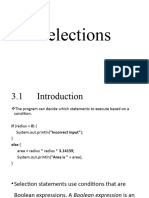0% found this document useful (0 votes)
28 views23 pagesLesson 6 - Relational Operators - Control Statement
The document discusses relational operators and control statements in computer programming. Relational operators allow comparisons to evaluate to true or false, and control statements like if/else and loops use conditional logic to direct program flow. Examples are provided of using relational operators in logical expressions and if/else statements to evaluate conditions and produce different outputs.
Uploaded by
daniellagatmaitanCopyright
© © All Rights Reserved
We take content rights seriously. If you suspect this is your content, claim it here.
Available Formats
Download as PDF, TXT or read online on Scribd
0% found this document useful (0 votes)
28 views23 pagesLesson 6 - Relational Operators - Control Statement
The document discusses relational operators and control statements in computer programming. Relational operators allow comparisons to evaluate to true or false, and control statements like if/else and loops use conditional logic to direct program flow. Examples are provided of using relational operators in logical expressions and if/else statements to evaluate conditions and produce different outputs.
Uploaded by
daniellagatmaitanCopyright
© © All Rights Reserved
We take content rights seriously. If you suspect this is your content, claim it here.
Available Formats
Download as PDF, TXT or read online on Scribd
/ 23























































































